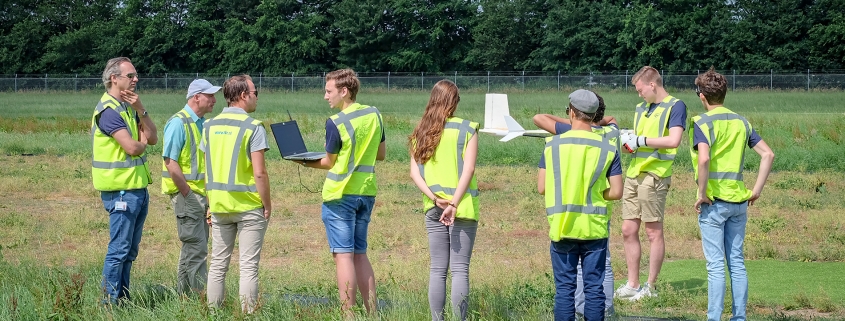Last week, a number of remotely piloted aircraft designed by students at the Amsterdam University of Applied Sciences (HvA) completed their maiden flight at a facility of the Netherlands Aerospace Centre (NLR). The flight tests were part of a third-year minor called ‘Design, Build and Fly’ (DBF) at HvA, which is aimed at helping students gain expertise and experience in designing, constructing and programming Remotely Piloted Aircraft Systems (RPAS), popularly known as ‘drones’. The flights took place under NLR’s responsibility at the Netherlands RPAS Test Centre (NRTC) in Marknesse. Two of the four aircraft successfully completed all elements of the flight test.
The DBF minor is a standard part of the Aviation Studies programme at HvA. The four participating teams had to adhere to a number of conditions, including a maximum wing span of two metres and a requirement to use innovative materials such as composites as well as 3D-printed plastic components. The hardware – such as the autopilot system and other electronics – was supplied by HvA. The students constructed the drones in an HvA technical workshop based on the prevailing technical requirements.
The four electrically powered aircraft had to complete a number of challenges as part of the maiden flight. In the morning, the maximum speed and maximum angle of climb were determined during a test flight. The drones also completed a gliding flight with their engines switched off. In the afternoon, the aircraft had to automatically deliver a parcel at a predefined location and subsequently complete a landing.
In a follow-up assignment, the students will check if the air speed, lift curve and other parameters calculated in advance match the actual data recorded by the autopilot system. Each team’s final grade is not only based on performance during the flight test, but also on an assessment of the aircraft’s design and construction, the accuracy of the aforementioned calculations, and the analyses and reports produced after the flight test. Teamwork and communication are also considered in the final assessment.
The flights took place under the responsibility of NLR because the students did not possess the licence required to act as ‘professional’ pilots. In addition, no airworthiness certificates had been issued for the drones. In the week prior to the test flight, NLR researchers already conducted inspections on the ground to check the airworthiness of the aircraft. Further to the findings, NLR staff proposed a number of mandatory modifications to one drone.
Enriched by their experiences and armed with useful tips from NLR, the students returned to HvA. Providing low-threshold access to facilities like the NRTC and sharing knowledge for educational purposes is one of the ways in which NLR fulfils its aim of contributing to society. In particular, this NLR programme contributes to training students in aircraft design and the application of state-of-the-art technologies in the design process. Eventually, this will help strengthen the competitive position and innovative capacity of the Dutch aerospace industry.





 NLR - Netherlands Aerospace Centre
NLR - Netherlands Aerospace Centre